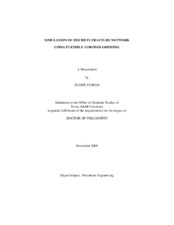| dc.description.abstract | Fractured reservoirs are generally simulated using Warren and Root26 dual-porosity (DP)
approach. The main assumption of this approach is that the geometry of fractures are
uniformly distributed and interconnected in reservoirs. This may be true for many cases of
naturally fractured reservoirs. However, for a large scale and disconnected fractured
reservoirs, DP is often not applicable. Due to the latter case, it is necessary to have more
sophisticated simulation studies which allow the fracture to be geometry explicitly
represented into the static model using Discrete Fracture Network (DFN) approach.
Most work on DFN grid model up to recently has been done with Delaunay
tessellations. This research proposes an alternative technique to discretize the two-dimensional
DFN using Voronoi diagrams, nevertheless applying the same DFN principles
outlined in previous work.
Through complicated procedures to generate DFN model, grid system based on
Voronoi polygons has been developed. The procedure will force Voronoi edges follow the
exact geometry of fractures. Furthermore, implementing the Voronoi diagrams allows the
use of fewer polygons than the traditional Local Grid Refinement (LGR). And most
importantly, due to the nature of the Voronoi polygons or locally orthogonal grids, the
transmissibility calculations can be simplified and are more accurate than corner point
formulation for non-square grid blocks.
Finally, the main and most important goal of this study is to develop a black-oil
Control Volume Finite Difference (CVFD) reservoir simulator that allows us to model DFN more realistically. One of the features of the developed simulator is the capability to
model individual fractures with non-uniform aperture distribution, such as log-normally
distributed apertures as shown using X-Ray CT scanner measurements.
Prior to using the DFN simulator to model reservoirs with fractures and their
apertures distribution, the simulator was validated against commercial simulators. The
simulator provides results in close agreement with those of a reference finite-difference
simulator in cases where direct comparisons are possible.
Several simulations of synthetic DFN were presented to demonstrate the robustness
of the Voronoi diagrams to represent fracture networks and its aperture distributions. In
summary, the simulation of the DFN using the proposed approaches is capable to model
both fractured and unfractured systems. However, the DFN model with Voronoi grids
requires more efforts on building the grid model compared to other methods. Numerically,
simulations of fractured systems are very challenging. | en |


